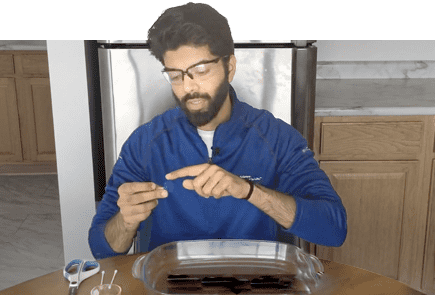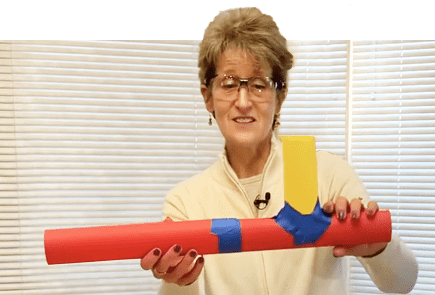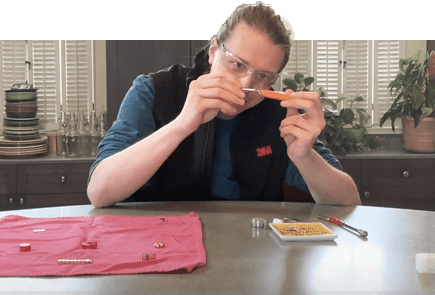How do our lungs work? Follow along as special guest Dakota Dozier, an offensive guard for the Minnesota Vikings, makes a model to show how air flows in and out of the lungs with ease.
Background
We breathe a lot—roughly 10 times a minute! Have you ever wondered how the process of breathing works so smoothly? Our lungs allow us to inhale the oxygen our body needs, but they do much, much more. They also allow us to get rid of carbon dioxide, the waste product created in the body, and they play a vital role in singing, shouting and even giggling. In this activity you will make a model of a lung and use it to discover how air flows in and out of the lungs with ease.
Key Concepts
- Biology
- The body
- Physics
- Air pressure
Materials
- Disposable empty transparent bottle (16 fluid ounces) made of hard plastic (such as a sports drink bottle)
- Ruler
- Two balloons (8-inch balloons work well)
- Utility knife (have an adult help and use caution when using the knife)
- Adult helper
- Scissors
- Drinking straw (optional)
- Modeling clay (optional)
- Tape (optional)
- Additional balloon (optional)
Preparation
- Ask an adult to cut the plastic bottle. Cut off the bottle's bottom so that when a balloon hangs inside the bottle from the spout there is about 1/3 to 3/4 of an inch of empty space below the balloon.
- Place the cut bottle down on the wide opening. Lower a balloon into the bottle until only part of the balloon's neck sticks out. Fold the neck of the balloon over the top of the bottle. The balloon represents a lung.
- Turn the bottle over (keeping the balloon inside) so the bottle top rests on the table. In the next steps you will create and add the diaphragm to your model.
- Make a knot in the neck of the second balloon. At the opposite side of this balloon cut off about a third of the balloon so you are left with a wide opening.
- Stretch the wide opening of the cut balloon over the wide opening of the bottle. Pull the edges of the balloon far enough up the bottle so the balloon surface is gently stretched. Make sure that the knot is on the outside and located near the middle of the bottle opening.
- Like an inflated balloon our lungs are full of air. We have two lungs, which are enclosed in the ribcage and protected by 24 ribs. When you breathe in, air flows into your lungs. When you breathe out, air flows out of your lungs. The balloon inside the bottle is like one of your lungs. The bottle is like your ribcage.
- Hold the bottle so you can see the balloon inside (representing the lung). Gently pull down on the knot. What happens to the balloon inside the bottle?
- Let the knot come back to its neutral position and then gently push it in. What happens to the balloon inside the bottle now?
- Repeat these steps a few times. Does this resemble breathing? Why?
- Which part resembles breathing in and which part resembles breathing out?
- If your model is working well, air will rush into the balloon when you pull the knot outward and flow out when you push the knot inward. Why do you think this happens?
- When we breathe in a relaxed way our diaphragm—the muscle that separates the chest cavity from the abdominal cavity—moves to expand and contract the chest cavity. How is that similar to what you do with your model?
- Push and pull the knot a few more times. Using the model can you find which movement of the diaphragm creates inhalation and which creates exhalation?
- Feel your ribs and breathe in deeply then exhale. Can you feel your ribcage expand and fall back?
- The center of our diaphragm moves more when we take deep breaths: up to four inches! In the model you made, the ribcage (the plastic bottle) is fixed, but you can move the "diaphragm" more by pulling the knot farther and pushing it in more. Try it out. How does that change the volume of air that flows in and out of the lung balloon?
- Extra: Add a windpipe to your model. To do this take the balloon out of the bottle and slip its neck over a straw; secure the balloon to the straw with tape. Hang the balloon—and a short section of the straw—in the bottle's neck and use clay to hold it in place. Make sure the clay makes an airtight seal around the straw and the bottle neck. No change is needed to the second balloon that closes off the bottom of the bottle. Can you see which part models the windpipe?
- Extra: A cough is the body forcefully expelling air to get rid of something that caused irritation. During a cough you breathe in relatively deeply but instead of air flowing out while the chest cavity contracts, your throat closes, and air builds up in the lungs. When the throat opens the chest contracts even more and air flows out in a forceful way. Can you mimic a cough with your model?
- Extra: Find a way to create a model that includes a windpipe that splits into two bronchi, each with a lung attached. The model with a windpipe and one lung is a good start. How can you add a second lung? Can you find a reason why having two lungs is beneficial for us?
Observation and Results
When you pulled the knot back, the space inside the bottle increased and your balloon probably filled up with air. In the same way, when the diaphragm in our body pulls back, the chest cavity increases and air flows into our lungs, and we inhale.
When you pushed the knot in, the space inside the bottle decreased, and the balloon probably deflated. In the same way, when the diaphragm relaxes the chest cavity decreases, and air is pushed out of the lungs, and we exhale.
When you pulled and pushed the knot further the balloon inflated and deflated more. This mirrors what happens when a bigger volume of air is displaced when we breathe more deeply.
This dynamic works because of air pressure, a measure of how hard air presses against objects. Air pressure increases when you decrease the amount of space the air has—and decreases when you give air more space. Close a flimsy empty plastic bottle and try to compress it. It is difficult! The air inside pushes back. Open the bottle and try to compress the bottle again. It is much easier. The air presses back with a much reduced force. Unless something blocks the movement, air will move from areas of high pressure to areas where the pressure is lower, and this is what happens when air rushes in or out of the lungs. When the chest cavity expands there is more space around your lungs. In this condition the lungs can expand, making it a low-pressure area, and air rushes in to balance out the difference in pressure. Then to breathe out the chest cavity and lungs shrink. This raises the air pressure in your lungs, and the air rushes back out.
Safety First and Adult Supervision
- Follow the experiment’s instructions carefully.
- A responsible adult should assist with each experiment.
- While science experiments at home are exciting ways to learn about science hands-on, please note that some may require participants to take extra safety precautions and/or make a mess.
- Adults should handle or assist with potentially harmful materials or sharp objects.
- Adult should review each experiment and determine what the appropriate age is for the student’s participation in each activity before conducting any experiment.
Next Generation Science Standard (NGSS) Supported - Disciplinary Core Ideas
This experiment was selected for Science at Home because it teaches NGSS Disciplinary Core Ideas, which have broad importance within or across multiple science or engineering disciplines.
Learn more about how this experiment is based in NGSS Disciplinary Core Ideas.
Engineering Design (ETS)1: Engineering Design
Grades K-2
- 2-PS1-1. Different kinds of matter exist and many of them can be either solid or liquid depending on temperature. Matter can be described and classified by its observable properties.
Grades 3-5
- 5-PS1-1.
- Matter of any type can be subdivided into particles that are too small to see, but even then, the matter still exists and can be detected by other means.
- A model shows that gases are made from matter particles that are too small to see and are moving freely around in space. This can explain many observations, including the inflation and shape of a balloon and the effects of air on larger particles or objects.
- 5-PS1-2. The amount (weight) of matter is conserved when it changes form, even in transitions in which it seems to vanish.
Grades 6-8
- MS-PS1-1.
- Substances are made from different types of atoms, which combine with one another in various ways.
- Atoms form molecules that range in size from two to thousands of atoms.
- MS-PS1-4.
- Gases and liquids are made of molecules or inert atoms that are moving about relative to each other.
- In a gas, they are widely spaced except when they happen to collide.
Grades K-2
- K-PS2-1. Pushes and pulls can have different strengths and directions.
- K-PS2-2. Pushing or pulling on an object can change the speed or direction of its motion and can start or stop it.
Grades 3-5
- 3-PS2-1. Each force acts on one particular object and has both strength and direction. An object typically at rest has multiple forces acting on it, but they add to give zero net force on the object. Forces that do not sum to zero can cause changes in the object's speed or direction of motion.
- 3-PS2-2. The patterns of an object's motion in various situations can be observed and measured; when that past motion exhibits a regular pattern, future motion can be predicted from it.
Grades 6-8
- MS-PS2-1. For any pair of interacting objects, the force exerted by the first object on the second object is equal in strength to the force that the second object exerts on the first, but in the opposite direction (Newton's third law.)
- MS-PS2-2. The motion of an object is determined by the sum of the forces acting on it; if the total force on the object is not zero, its motion will change. The greater the mass of the object, the greater the force needed to achieve the same change in motion. For any given object, a larger force causes a larger change in motion.
Grades 9-12
- HS-PS2-1. Newton's second law accurately predicts changes in the motion of macroscopic objects.
Grades K-2
- K-PS2-1. When objects touch or collide, they push on one another and can change motion.
Grades 3-5
- 3-PS2-1. Objects in contact exert forces on each other.
Grades K-2
- K-PS2-1. A bigger push or pull makes things go faster.
Grades 3-5
- 4-PS3-3. When objects collide, the contact forces transfer energy so as to change the objects’ motions.
Grades 6-8
- MS-PS3-2. When two objects interact, each one exerts a force on the other that can cause energy to be transferred to or from the object.
Grades 9-12
- HS-PS3-5. When two objects interacting through a field change relative position, the energy stored in the field is changed.
Grades 3-5
- 4-PS3-4. The expression "produce energy" typically refers to the conversion of stored energy into a desired form for practical use.
- 5-PS3-1. The energy released from food was once energy from the Sun that was captured by plants in the chemical process that forms plant matter.
Grades 3-5
- 4-LS1-1. Plants and animals have both internal and external structures that serve various functions in growth, survival, behavior, and reproduction.
Grades 6-8
- MS-LS1-3. In multicellular organisms, the body is a system of multiple interacting subsystems. These subsystems are groups of cells that work together to form tissues and organs that are specialized for particular body functions.
Grades 6-8
- MS-LS1-6. As matter and energy flow through different organizational levels of living systems, chemical elements are recombined in different ways to form different products. The chemical reaction by which plants produce complex food molecules requires an energy input to occur. In this reaction, carbon dioxide and water combine to form carbon-based organic molecules and release oxygen.
- MS-LS1-7. Cellular respiration in plants and animals is a chemical process whereby the bonds of food molecules and oxygen molecules are broken and new compounds are formed that can transport energy to muscles. Cellular respiration also releases the energy needed to maintain body temperature despite ongoing energy transfer to the surrounding environment.
Explore Additional Science at Home Videos and Activities

Soap Boat
Join 3M Researcher Vasav Shani as he introduces you to the science of surface tension.
Not only is it only important for many engineering and earth science processes, it also makes blowing bubbles possible.

Bernoulli Balance
A jetliner can weigh over 300 tons, so why doesn’t it just drop out of the air?
3M’s SVP of Corporate Affairs, Denise Rutherford explains the Bernoulli principle and how without it, planes (and birds) couldn’t fly.

Push and Pull
Follow along with 3M’s Sam Reiss, as he shows you that magnetism is more than just a simple push and pull – it’s an example of the power of the earth itself.

